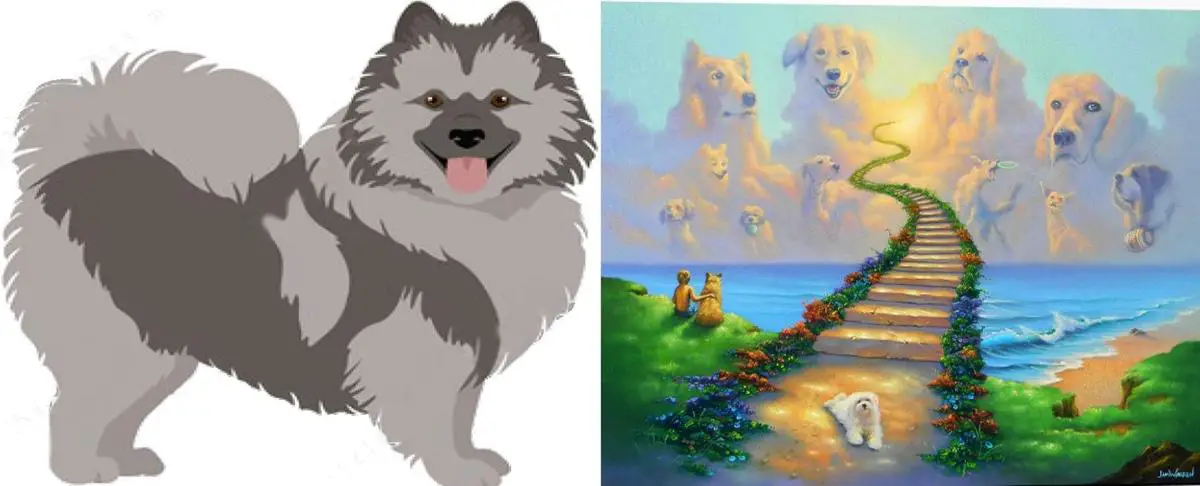Quick Links: Table of Contents
- How Long Keeshonds Live. Keeshond Life Expectancy
- Lifespan of the Keeshond Compared to Other Dog Breeds
- Common Causes of Death in Keeshond, and how to Prevent Them.
- How To Prevent Genetic Problems in Keeshonds
- How Old is Your Keeshond in Human Years
- How Long Do Keeshonds Live in Human Years?
- More Ways to Make Your Keeshond Live Long
- Conclusion on Keeshond Life Expectancy
How Long Keeshonds Live. Keeshond Life Expectancy
Generally, the lifespan of the Keeshond is from 12 to 15 years.
Moreover, a few years back, British Veterinarinan researchers performed a scientific study to determine the lifespan of the Keeshond. In this study, the scientists collected data on how long 104 pet Keeshonds lived.
From the study, it was found that Keeshonds have a average lifespan of 12.2 years. Furthermore, the study found that Keeshonds can live for as long as 16.0 years.
Furthermore, researchers from the University of Georgia conducted a study to find out what are the top causes of death in Keeshonds.
According to the study, the top 5 causes of death in Keeshonds are:
- Neoplastic Disease: Issues involving tumors
- Gastrointestinal Disease: Any problems that affect the mouth, esophagus, stomach, intestines, colon, or rectum.
- Urogenital Disease: Problems with the kidneys, urinary tract, and/or reproductive organs
- Cardiovascular Disease: Encompasses heart problems, blood pressure issues, and bleeding/clotting problems. CV issues may also be related to lung and/or breathing problems.
- Metabolic Disease: Problems having to do with the storage or breakdown of nutrients
In this article, we will explain each of these diseases and discuss how to prevent the early occurence of each in your Keeshond to make your Keeshond live a longer.
Also, in this article, we will discuss other things you can do to ensure that your Keeshond have a longer than average lifespan.
Do you want to know how old your Keeshond is in human years? Then, check out our Keeshond age to human years calculator
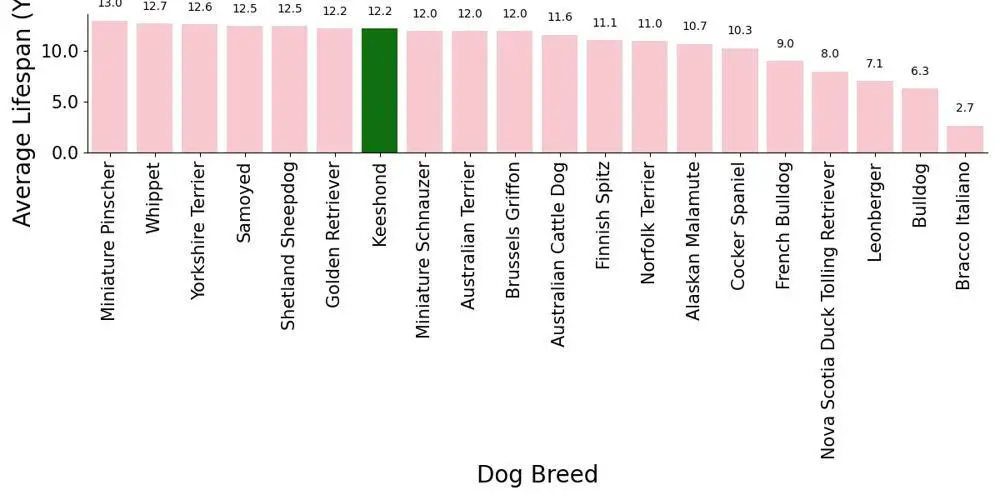
Lifespan of the Keeshond Compared to Other Dog Breeds
See in the table below how the lifespan of the Keeshond compares to the lifespan of other dog breeds.
| Dog Breed | Average Lifespan (Years) |
|---|---|
| Miniature Pinscher Lifespan | 13.00 |
| Whippet Lifespan | 12.70 |
| Yorkshire Terrier Lifespan | 12.60 |
| Samoyed Lifespan | 12.50 |
| Shetland Sheepdog Lifespan | 12.50 |
| Golden Retriever Lifespan | 12.20 |
| Keeshond Lifespan | 12.20 |
| Miniature Schnauzer Lifespan | 12.00 |
| Australian Terrier Lifespan | 12.00 |
| Brussels Griffon Lifespan | 12.00 |
| Australian Cattle Dog Lifespan | 11.60 |
| Finnish Spitz Lifespan | 11.10 |
| Norfolk Terrier Lifespan | 11.00 |
| Alaskan Malamute Lifespan | 10.70 |
| Cocker Spaniel Lifespan | 10.30 |
| French Bulldog Lifespan | 9.00 |
| Nova Scotia Duck Tolling Retriever Lifespan | 8.00 |
| Leonberger Lifespan | 7.08 |
| Bulldog Lifespan | 6.29 |
| Bracco Italiano Lifespan | 2.67 |

Common Causes of Death in Keeshond, and how to Prevent Them.
We will now discuss the common causes of death in Keeshond, according to scientific research. Also we will provide you advice on how to prevent these problems in your Keeshond.
Here are the causes of death, starting from the most common cause
-
Neoplastic Disease in Keeshonds
Neoplasms, or tumors, can be benign (like a lipoma), or malignant (cancer).
Neoplastic Disease is responsible for 28.0 percent of all deaths in Keeshonds.
Causes of Neoplastic Disease in Keeshond
Neoplasms in dogs, just like in people, are caused by either a genetic predisposition (like some breast cancers), an environmental factor (like smoking in humans), or a combination of both.
How to Prevent Neoplastic Disease in Keeshonds
Just like in humans, there is little you can do to prevent cancers that are caused by genetic factors. You can, however, reduce the environmental risks that are associated with cancer. The `environmental` causes of neoplasia are chemical agents, infectious agents, and physical agents. An example of a chemical agent that could cause cancer in Keeshonds (and humans) is asbestos. An example of an infectious agent that could cause cancer in Keeshonds is the virus called canine adenovirus. An example of a physical agent that can cause cancer in Keeshonds is UV radiation from the sun, just like in humans.
Another way to prevent neoplasms in Keeshonds is to vaccinate them against harmful viruses, such as canine adenovirus (DHPP vaccine at 8 and 12 weeks and then once a year, every year). As in humans, early diagnosis is the key to supporting Keeshonds with neoplasms, so talk to your veterinarian if you find any new lumps, bumps, or discoloration on your Keeshond. You should also talk to your veterinarian if your Keeshond`s gums look pale.
-
Gastrointestinal Disease in Keeshonds
Gastrointestinal diseases includes vomiting, diarrhea, nausea, stomach upset, blockages, toothache, constipation, and more.
Gastrointestinal Disease is responsible for 15.2 percent of all deaths in Keeshonds.
Causes of Gastrointestinal Disease in Keeshond
GI problems can be caused by a lot of different things. Often, GI problems like vomiting and diarrhea are caused by things that were eaten. It is best not to let your Keeshond eat human food or anything it finds outside, including garbage, plants and berries, fecal matter from other animals, and more. Vomiting, diarrhea, and stomach upset can also be caused by bacterial, viral, and parasitic infections. Another important sign of GI problems is when your Keeshond stops eating or eats less than usual. This can be caused by many things; sometimes it could be that your Keeshond is feeling nauseous, sometimes it could be that your Keeshond has mouth pain, and more. In these cases, it is best to see a veterinarian to get to the root of the problem.
How to Prevent Gastrointestinal Disease in Keeshonds
An easy way to protect your dog from gastrointestinal problems is to make sure they are on heartworm, flea, and tick medicine all year long (no matter where you live). Many heartworm medications can also de-worm your dog every time you give a dose. This can prevent nasty parasites from settling into your dog`s intestines and causing pain, anemia, and other serious issues. Another way you can keep your dog feeling good is by taking good care of their teeth! This is especially an issue in small dogs. The best way to care for dog teeth is by cleaning them a few times a week. Here is a great brush for cleaning your Keeshond`s teeth. However, if your dog will not allow you to do that, dental treats like these are a good second option.
-
Urogenital Disease in Keeshonds
Urogenital problems most often involve infections and blockages, which various degrees of seriousness.
Urogenital Disease is responsible for 12.1 percent of all deaths in Keeshonds.
Causes of Urogenital Disease in Keeshond
Probably, the most important urogenital issue seen in intact female Keeshonds is the pyometra. A pyometra is an enlarged, pus-filled uterus caused by a severe bacterial infection. A pyometra is several times larger than a regular uterus and is a life-threatening condition. To treat a pyometra, the Keeshond`s uterus must be removed, which is a difficult and expensive surgery. Another urogenital infection seen in both female and male dogs is urinary tract infections, which are very similar to human UTIs. If left untreated, UTIs can ascend up the urinary tract and infect the kidneys, which can also be life-threatening. If you notice that your Keeshond is urinating much more or less frequently than usual, or if the color or smell of the urine seems different from normal, you should talk to your veterinarian. Another common urogenital issue in male Keeshonds is urinary blockages, which (as the name suggests) is when there is something stuck in the urinary tract which prevents the Keeshond from urinating. If you see your Keeshond lifting its leg and trying to urinate but nothing is coming out, you should call your veterinarian. Cancer is also a major urogenital issue in Keeshonds, just like it is in humans. Urinary incontinence can also be an issue in both male and female Keeshonds, just like in humans.
How to Prevent Urogenital Disease in Keeshonds
The only way to completely prevent a pyometra is by getting your female Keeshond spayed. Another major benefit to spaying your Keeshond is that it dramatically reduces her risk of breast cancer. A spay is a major surgery and does tend to be a bit more expensive than a neuter, but a pyometra surgery is probably 3-4 times more expensive and dangerous than a regular, routine spay. Neutering your male Keeshond will also dramatically reduce his risk of prostate cancer and urinary blockages, especially as he gets older. If the spay and neuter estimates from your regular veterinarian are a little out of your price range, low-cost high-volume (LCHV) spay and neuter clinics are also an excellent option. If you find that your Keeshond is prone to blockages even though they are sterilized, there are many diets and supplements like this that can help. There are also diets like this and supplements that can help with urinary incontinence, but if these don`t work, your veterinarian can also prescribe prescription medications.
-
Cardiovascular Disease in Keeshonds
Cardiac problems may include valvular and vascular disorders, which ultimately lead to the heart`s inability to pump oxygen-rich blood to tissues. Cardiac issues can be acute or chronic, and can lead to progressive heart failure or sudden death.
Cardiovascular Disease is responsible for 10.5 percent of all deaths in Keeshonds.
Causes of Cardiovascular Disease in Keeshond
Heart disease in Keeshonds may be caused by genetic (inherited) factors, lack of exercise, and poor diet. Heart disease can also be caused by infections such as bacteria (endocarditis, myocarditis, and more) as well as viruses, fungi, and parasites (heartworm).
How to Prevent Cardiovascular Disease in Keeshonds
You can prevent heart problems in your Keeshond by exercising your Keeshond regularly and feeding your Keeshond a good diet. Heartworm, which causes heart problems, is also very easily avoided by using preventatives. Giving your dog the following supplements can help prevent heart diseases. Here is a good supplement that can prevent heart problems in your Keeshond. The supplement is not only good for your Keeshond`s heart, but it is also good for your Keeshond`s overall health.
-
Metabolic Disease in Keeshonds
Metabolic problems can be caused by genetic or acquired storage diseases as well as issues with the production of important molecules, such as hyper- or hypoglycemia.
Metabolic Disease is responsible for 9.7 percent of all deaths in Keeshonds.
Causes of Metabolic Disease in Keeshond
Metabolic disorders may be developmental (in the fetus) or may be acquired by eating certain toxic plants, such as American aloe plants.
How to Prevent Metabolic Disease in Keeshonds
You can prevent metabolic problems in your Keeshond by making sure your Keeshond does not accidentally eat toxic plants and food.

How To Prevent Genetic Problems in Keeshonds
Every dog breed has a set of genetic problems to which it is predisposed, and the Keeshond is not an exception.
These disease will reduce your Keeshond`s qualilty of life. Also, these diseases can shorten your Keeshond`s lifespan.
The good news is that these diseases can be prevented in Keeshond offsprings by only breeding Keeshond that have been screened and cleared of genetic defects.
The Orthopedic Foundation for Animals (OFA) is one the organizations that keep records of which disease to which a dog breed is genetically prone.
The OFA provides breeders recommendations on which genetic diseases that breeders should screen their dog parents and puppies for.
If you want a Keeshond puppy that will grow up to be healthy and live long, make sure that your Keeshond breeder screens your puppy or your puppy`s parents for the health problems that the OFA recommends for your puppy`s breed. This will increase the chances that your puppy is free from genetic defects.
If you do not know if your Keeshond has been screened for genetic health problems, then your can use an at-home genetic screening kit like this one to check your Keeshond for genetic health problems at home. This might help you in deciding whether to get your Keeshond a pet health insurance.
The following are the health tests that Orthopedic Foundation for Animals (OFA) recommends that breeders should screen Keeshonds for:
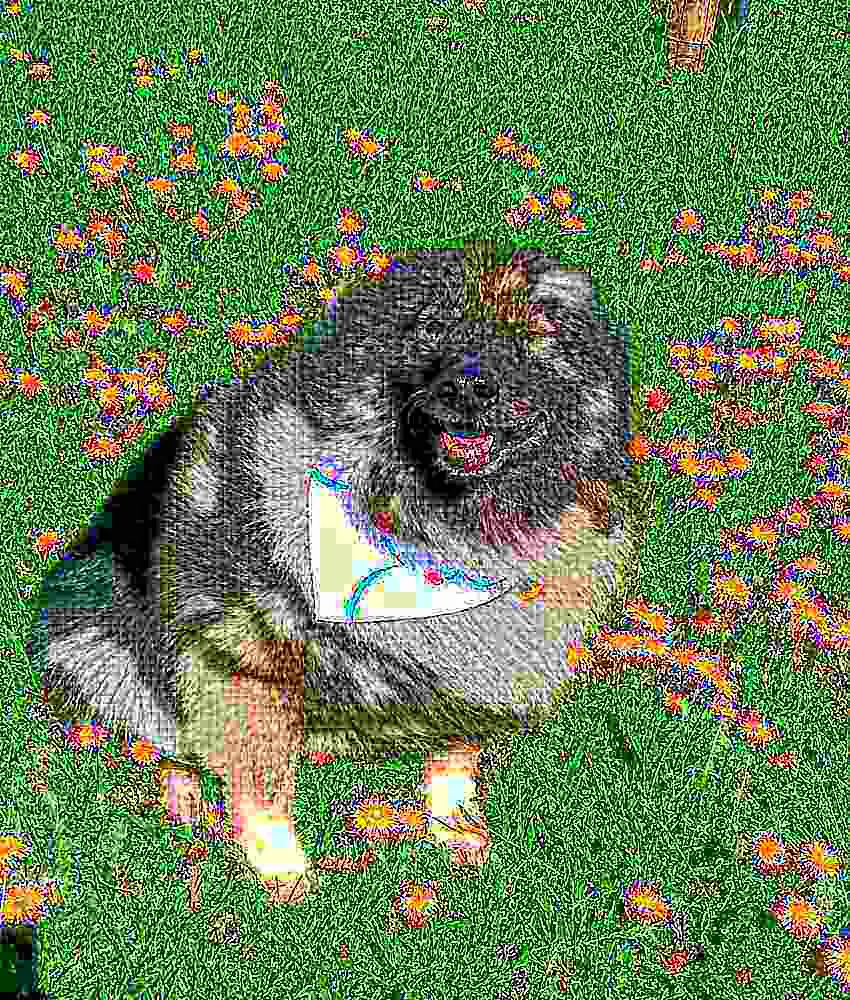
How Old is Your Keeshond in Human Years
The table below shows your human years equivalent age of your Keeshond. This table is based on a dog-to-human age study conducted by researchers from Purdue University.
Learn more about how old your Keeshond is in human years here.
In 1997, researchers from Purdue University developed a method for converting a dog`s age to its human age. Their method was based on the 1953 work of the French Veterinarian, A. Lebeau that we discussed above.
Researchers from Purdue University took Lebeau`s work further by taking into account two important factors to develop a more accurate method for converting a dog`s age into its human equivalent age:
- The size of the dog: Smaller dog breeds live longer than larger breed dogs
- The lifespan of the dog: Dog breeds that live longer lives will age slower than dog breeds that live shorter lives
The average lifespan of the Keeshond is 12.2 years.
Keeshonds are medium-sized dogs. Keeshonds weigh 35 to 45 pounds.
The method developed by the Purdue University veterinarian researchers took into account the lifespan and size of Keeshond in converting Keeshond age to human age.
The researchers used data on the lifespan and weight of 5,608 mixed breed dogs and 17,927 purebred dogs to develop their method for converting the ages of dogs (of different breed sizes and lifespans ) to their equivalent human ages.
The calculator below lets you convert your Keeshond`s age to its human age based on the Purdue University method. Just enter your Keeshond`s age in the calculator and it will compute your Keeshond`s human age. If you do not know your Keeshond`s exact age, enter an approximate age in the calculator.
Also, the table below shows how old your Keeshond is in human years based on the method developed by the researchers.
Note that your Keeshond`s human age changes day by day. Therefore, always check back to use the calculator to find your Keeshond`s up-to-date human age.
Keeshond Age to Human Age Calculator (Purdue Uni. Method)
Below is a Keeshond age to human age calculator that is based on the methods developed by researchers from Purdue University.
The calculator will tell your Keeshond`s human age based on your Keeshond`s dog birthday. Also, the calculator will tell you which day is your Keeshond`s human birthday! Try it out!
| Keeshond Age (Years) | Human Age (Years) |
|---|---|
| 1 | 14 |
| 2 | 21 |
| 3 | 26 |
| 4 | 32 |
| 5 | 37 |
| 6 | 42 |
| 7 | 46 |
| 8 | 50 |
| 9 | 54 |
| 10 | 58 |
| 11 | 62 |
| 12 | 66 |
| 13 | 71 |
| 14 | 75 |
| 15 | 80 |
| 16 | 85 |
How Long Do Keeshonds Live in Human Years?
The average lifespan of the Keeshond is 12.2 years. In human years, the Keeshond lives for 67 years.
How Old is 1-year-old Keeshond in Human Years?
A 1-year old Keeshond is 14 years old in human years.
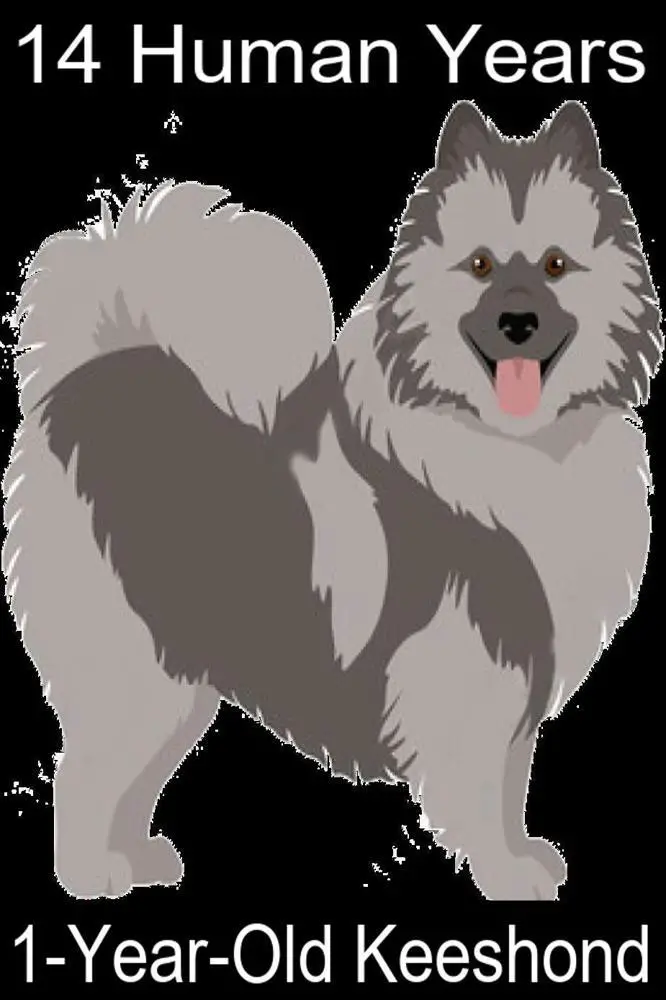
How Old is 2-year-old Keeshond in Human Years?
A 2-year old Keeshond is 21 years old in human years.
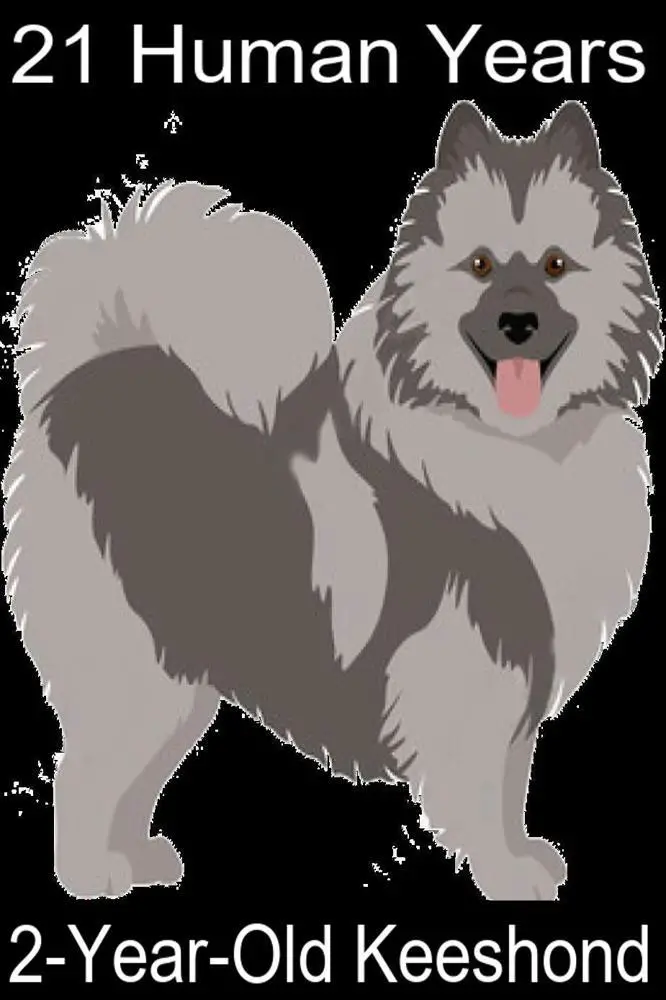
How Old is 6-year-old Keeshond in Human Years?
A 6-year old Keeshond is 42 years old in human years.
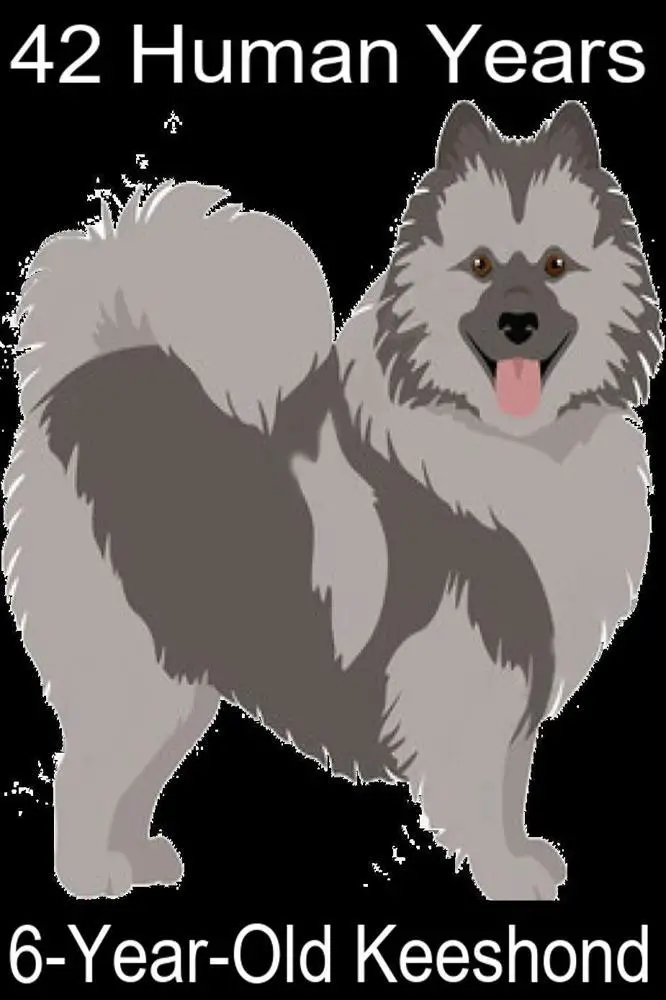
How Old is 11-year-old Keeshond in Human Years?
A 11-year old Keeshond is 62 years old in human years.
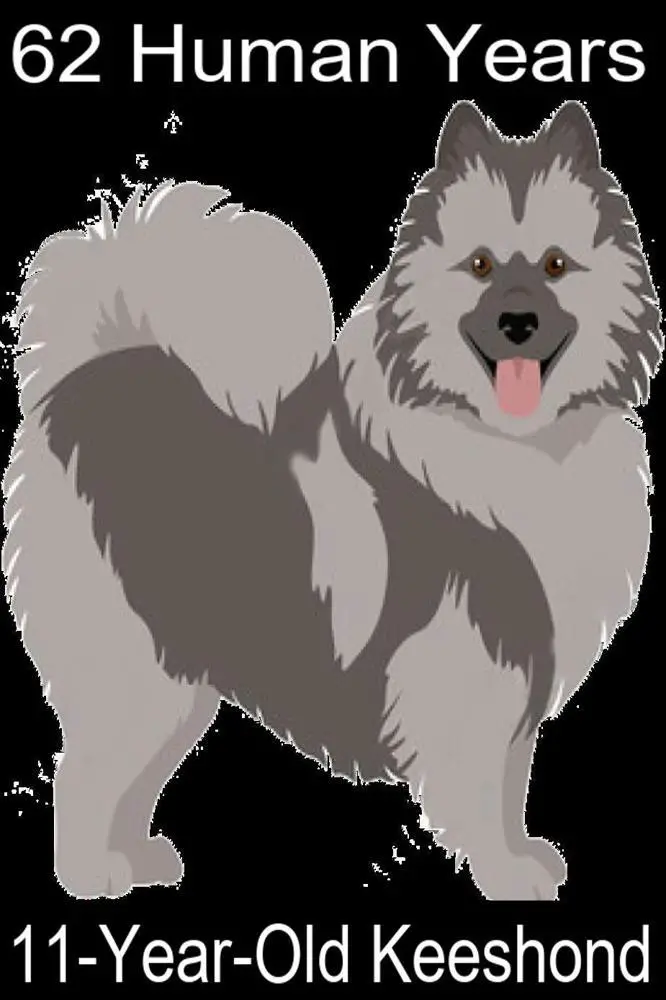
More Ways to Make Your Keeshond Live Long
Here are more things your can do to make sure your Keeshond live a long life:
-
Regular Exercise: Research studies have shown that one of the very effective ways to make a dog live long is to ensure that a dog is in good shape. Adequate exercise will make your Keeshond fit and make it live longer.
-
Good Diet: A poorly-fed, underweight Keeshond does not have a good chance of living a long life. Similarly, an overweight Keeshond will have a shorter lifespan than a Keeshond that is of normal weight. Therefore, it is important that your feed your Keeshond high-quality dog food without overfeeding your Keeshond. Check out our Keeshond feeding guide here. Learn how you can prevent your Keeshond from being overweight here.
-
Proper Hydration: Water is essential for your Keeshond existence. Therefore, you should make sure your Keeshond has access to clean water whenever your Keeshond needs water. However, too much water is bad for your Keeshond. See our Keeshond water drinking guide to learn more on how to properly hydrate your Keeshond.
-
Spaying/Neutering: Sterilizing your Keeshond might prolong its life. Check out this guideline to know when it is the best time to spay/neuter your Keeshond.
-
Routine Vet Care: Regular preventative visits to the vet can help catch diseases early.
-
Vaccinations: Always make sure your Keeshond is up to date on its vaccination.
-
Dental Hygiene: Your Keeshond’s teeth can get infected, and if the infection goes unnoticed, that infection can spread to other parts of the body and become systemic. This could lead to a shortened lifespan. You must have your Keeshond teeth cleaned professionally at your vet’s office a couple of times in its lifetime. Talk with your vet about the best ages to have these cleanings done.
Conclusion on Keeshond Life Expectancy
We hope the information we have provided will help your in increasing your Keeshond`s life expectancy.
Tate Ackerman contributed to this article. Tate is a second-year veterinary student at Kansas State University. Tate is also a concurrent Ph.D. student. She has a lot of experience reading scientific literature and communicating that information to a non-veterinary audience. Tate was a veterinary technician for a companion animal practice before she applied to veterinary school.